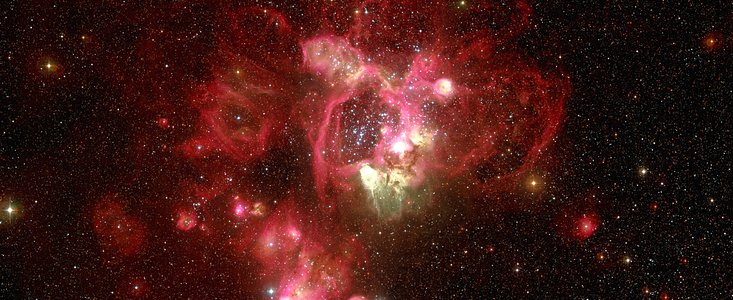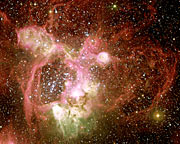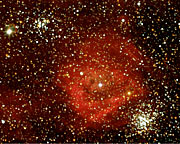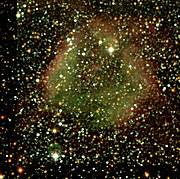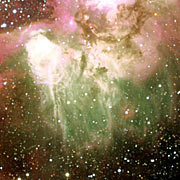Pressmeddelande
Roses in the Southern Sky
The Wide-Field-Imager at La Silla Unveils Intricate Structures Illuminated by Hot Stars
3 november 2003
The two best known satellite galaxies of the Milky Way, the Magellanic Clouds, are located in the southern sky at a distance of about 170,000 light-years. They host many giant nebular complexes with very hot and luminous stars whose intense ultraviolet radiation causes the surrounding interstellar gas to glow.
The intricate and colourful nebulae are produced by ionised gas [1] that shines as electrons and positively charged atomic nuclei recombine, emitting a cascade of photons at well defined wavelengths. Such nebulae are called "H II regions", signifying ionised hydrogen, i.e. hydrogen atoms that have lost one electron (protons). Their spectra are characterized by emission lines whose relative intensities carry useful information about the composition of the emitting gas, its temperature, as well as the mechanisms that cause the ionisation. Since the wavelengths of these spectral lines correspond to different colours, these alone are already very informative about the physical conditions of the gas.
N44 [2] in the Large Magellanic Cloud is a spectacular example of such a giant H II region. Having observed it in 1999, a team of European astronomers [3] again used the Wide-Field-Imager (WFI) at the MPG/ESO 2.2-m telescope of the La Silla Observatory, pointing this 67-million pixel digital camera to the same sky region in order to provide another striking - and scientifically extremely rich - image of this complex of nebulae. With a size of roughly 1,000 light-years, the peculiar shape of N44 clearly outlines a ring that includes a bright stellar association of about 40 very luminous and bluish stars.
These stars are the origin of powerful "stellar winds" that blow away the surrounding gas, piling it up and creating gigantic interstellar bubbles. Such massive stars end their lives as exploding supernovae that expel their outer layers at high speeds, typically about 10,000 km/sec.
It is quite likely that some supernovae have already exploded in N44 during the past few million years, thereby "sweeping" away the surrounding gas. Smaller bubbles, filaments, bright knots, and other structures in the gas together testify to the extremely complex structures in this region, kept in continuous motion by the fast outflows from the most massive stars in the area.
The new WFI image of N44
The colours reproduced in the new image of N44, shown in ESO Press Photo eso0332a (with smaller fields in more detail in ESO Press Photos eso0332b-e) sample three strong spectral emission lines. The blue colour is mainly contributed by emission from singly-ionised oxygen atoms (shining at the ultraviolet wavelength 372.7 nm), while the green colour comes from doubly-ionised oxygen atoms (wavelength 500.7 nm). The red colour is due to the H-alpha line of hydrogen (wavelength 656.2 nm), emitted when protons and electrons combine to form hydrogen atoms. The red colour therefore traces the extremely complex distribution of ionised hydrogen within the nebulae while the difference between the blue and the green colour indicates regions of different temperatures: the hotter the gas, the more doubly-ionised oxygen it contains and, hence, the greener the colour is.
The composite photo produced in this way approximates the real colours of the nebula. Most of the region appears with a pinkish colour (a mixture of blue and red) since, under the normal temperature conditions that characterize most of this H II region, the red light emitted in the H-alpha line and the blue light emitted in the line of singly-ionised oxygen are more intense than that emitted in the line of the doubly-ionised oxygen (green).
However, some regions stand out because of their distinctly greener shade and their high brightness. Each of these regions contains at least one extremely hot star with a temperature somewhere between 30,000 and 70,000 degrees. Its intense ultraviolet radiation heats the surrounding gas to a higher temperature, whereby more oxygen atoms are doubly ionised and the emission of green light is correspondingly stronger, cf. ESO Press Photo eso0332c.
A selection of fields in the N44 complex
By contrast, this image was a three-colour composite produced by means of two broad-band filter exposures in blue and green light and one H-alpha exposure, and therefore outlining the general appearance of the ionised region. Says Fernando Comerón, leader of the team: "Thanks to the use of a UV-filter and two narrow-band filters isolating the emission of specific ions, the new picture provides much more information about the complicated physics of the excited interstellar gas in the region."
Nausicaa Delmotte, member of the team, adds: "With its colourful beauty, N44 is a display of the violent phenomena that occur as the heaviest known stars unfold their power on the parental gas out of which they were born."
Noter
[1] A gas is said to be ionised when its atoms have lost one or more electrons - in this case by the action of energetic ultraviolet radiation emitted by very hot and luminous stars close by.
[2] The letter "N" (for "Nebula") in the designation of these objects indicates that they were included in the "Catalogue of H-alpha emission stars and nebulae in the Magellanic Clouds" compiled and published in 1956 by American astronomer-astronaut Karl Henize (1926 - 1993).
[3] The team is composed of Fernando Comerón and Nausicaa Delmotte from ESO, and Annie Laval from the Observatoire de Marseille (France).
Mer information
The colour picture of N44 in the LMC is based on three monochromatic images taken on 6 and 7 December 2001 with the Wide-Field-Imager (WFI) at the ESO/MPG 2.2-m telescope, using the U-band filter (containing the forbidden line of singly-ionised oxygen, [OII], at 372.7 nm) and two narrow-band filters centred, respectively, on the wavelengths of the forbidden line of doubly-ionised oxygen ([OIII], at 500.7 nm) and hydrogen (H-alpha line, at 656.2 nm). Each single-colour image is in turn composed of four individual frames of 20 minutes of exposure time each.
The WFI detector system is composed of eight individual 2k x 4k CCDs with small gaps between them; for this reason, the individual frames in each filter were obtained with the telescope pointing at slightly different positions in the sky, so that the parts of the sky falling in the detector gaps in any given frame are recorded on the others. A problem with one of the detector chips causes double stellar images to appear over a small, narrow strip near the upper left edge of the full field image. The monochromatic images were produced by superimposing the individual frames, correcting for the telescope offsets. Finally, the combined images in each filter were aligned and colour-coded to produce the resulting colour picture. North is up and East is left.
Kontakter
Fernando Comerón
ESO
Garching, Germany
Tel: +49-89-3200-6531
E-post: fcomeron@eso.org
Nausicaa Delmotte
ESO
Garching, Germany
Tel: +49-89-3200-6418
E-post: ndelmott@eso.org
Om pressmeddelandet
| Pressmeddelande nr: | eso0332 |
| Legacy ID: | Photo 31a-e/03 |
| Namn: | Dem L 144, KMHK 831, KMHK 840, Large Magellanic Cloud, LMC, N 44 |
| Typ: | Local Universe : Nebula : Appearance : Emission : H II Region |
| Facility: | MPG/ESO 2.2-metre telescope |
| Instruments: | WFI |
Our use of Cookies
We use cookies that are essential for accessing our websites and using our services. We also use cookies to analyse, measure and improve our websites’ performance, to enable content sharing via social media and to display media content hosted on third-party platforms.
ESO Cookies Policy
The European Organisation for Astronomical Research in the Southern Hemisphere (ESO) is the pre-eminent intergovernmental science and technology organisation in astronomy. It carries out an ambitious programme focused on the design, construction and operation of powerful ground-based observing facilities for astronomy.
This Cookies Policy is intended to provide clarity by outlining the cookies used on the ESO public websites, their functions, the options you have for controlling them, and the ways you can contact us for additional details.
What are cookies?
Cookies are small pieces of data stored on your device by websites you visit. They serve various purposes, such as remembering login credentials and preferences and enhance your browsing experience.
Categories of cookies we use
Essential cookies (always active): These cookies are strictly necessary for the proper functioning of our website. Without these cookies, the website cannot operate correctly, and certain services, such as logging in or accessing secure areas, may not be available; because they are essential for the website’s operation, they cannot be disabled.
Functional Cookies: These cookies enhance your browsing experience by enabling additional features and personalization, such as remembering your preferences and settings. While not strictly necessary for the website to function, they improve usability and convenience; these cookies are only placed if you provide your consent.
Analytics cookies: These cookies collect information about how visitors interact with our website, such as which pages are visited most often and how users navigate the site. This data helps us improve website performance, optimize content, and enhance the user experience; these cookies are only placed if you provide your consent. We use the following analytics cookies.
Matomo Cookies:
This website uses Matomo (formerly Piwik), an open source software which enables the statistical analysis of website visits. Matomo uses cookies (text files) which are saved on your computer and which allow us to analyze how you use our website. The website user information generated by the cookies will only be saved on the servers of our IT Department. We use this information to analyze www.eso.org visits and to prepare reports on website activities. These data will not be disclosed to third parties.
On behalf of ESO, Matomo will use this information for the purpose of evaluating your use of the website, compiling reports on website activity and providing other services relating to website activity and internet usage.
Matomo cookies settings:
Additional Third-party cookies on ESO websites: some of our pages display content from external providers, e.g. YouTube.
Such third-party services are outside of ESO control and may, at any time, change their terms of service, use of cookies, etc.
YouTube: Some videos on the ESO website are embedded from ESO’s official YouTube channel. We have enabled YouTube’s privacy-enhanced mode, meaning that no cookies are set unless the user actively clicks on the video to play it. Additionally, in this mode, YouTube does not store any personally identifiable cookie data for embedded video playbacks. For more details, please refer to YouTube’s embedding videos information page.
Cookies can also be classified based on the following elements.
Regarding the domain, there are:
- First-party cookies, set by the website you are currently visiting. They are stored by the same domain that you are browsing and are used to enhance your experience on that site;
- Third-party cookies, set by a domain other than the one you are currently visiting.
As for their duration, cookies can be:
- Browser-session cookies, which are deleted when the user closes the browser;
- Stored cookies, which stay on the user's device for a predetermined period of time.
How to manage cookies
Cookie settings: You can modify your cookie choices for the ESO webpages at any time by clicking on the link Cookie settings at the bottom of any page.
In your browser: If you wish to delete cookies or instruct your browser to delete or block cookies by default, please visit the help pages of your browser:
Please be aware that if you delete or decline cookies, certain functionalities of our website may be not be available and your browsing experience may be affected.
You can set most browsers to prevent any cookies being placed on your device, but you may then have to manually adjust some preferences every time you visit a site/page. And some services and functionalities may not work properly at all (e.g. profile logging-in, shop check out).
Updates to the ESO Cookies Policy
The ESO Cookies Policy may be subject to future updates, which will be made available on this page.
Additional information
For any queries related to cookies, please contact: pdprATesoDOTorg.
As ESO public webpages are managed by our Department of Communication, your questions will be dealt with the support of the said Department.
